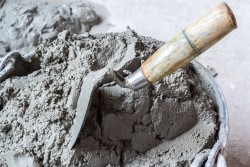Protecting Workers from Cement-Related Skin Conditions
Construction and other workers who come into contact with Portland cement have the potential to develop cement-related skin conditions. Portland cement is the term used to describe various materials that take on an adhesive property when mixed with water.
Materials that contain Portland cement include concrete, grout, mortar, plaster, stucco, and terrazzo. Portland cement contains a very small amount of hexavalent chromium. Hexavalent chromium is a toxin and harmful to the skin. Portland cement is more dangerous when it is wet.
When exposed to Portland cement, the following conditions can occur:
Cement burns: These burns can show up as blisters, dead or hardened skin, or black or green skin. Severe enough cement burns can reach the bones and cause scars and disability. Unfortunately, many time cement burns are not noticed until the damage has already occurred.
Dermatitis: This inflammation of the skin can cause itching, redness, swelling, blisters, scaling, and other conditions. There is also a condition called allergic contact dermatitis (ACD) that is present when sensitized individuals work with Portland cement. A sensitized individual means that a person’s immune system overreacts to small amounts Portland cement which can lead to severe inflammatory reactions upon subsequent exposures. While not everyone will become sensitized, if an individual does become sensitized, even very brief contact with Portland cement can trigger ACD.
The Occupational Safety and Health Administration (OSHA) has standards in place to keep workers safe from exposure to Portland cement. These standards require that:
- Personal protective equipment (PPE) must be provided, used, and maintained in a sanitary and reliable condition to protect employees from injury or impairment. Employees must be able to clean or exchange PPE if it becomes ineffective or contaminated.
- Washing facilities are available to employees exposed to Portland cement. These facilities provide clean water, non-alkaline soap, and clean towels.
- Manufacturers and importers of Portland cement must provide information on material safety data sheets (MSDSs) and labels regarding the hazards of Portland cement. Employers must make these MSDSs and labels available to employees. Employers are also required to provide training to communicate the hazards of exposure to Portland cement to their employees.
- Employers are required to inform employees about how to report work-related injuries and illnesses and record all new cases of work-related injury and illness.
- Employers must limit airborne exposure to Portland cement to 15 milligrams per cubic meter (mg/m3) of air for total dust and 5 mg/m3 for respirable dust.
Of course prevention is always the best protection when it comes to cement-related skin problems. Employers and employees should minimize skin contact with wet Portland cement and comply with OSHA requirements. Further, maintaining good skin hygiene and safe work practices maximizes protection against contact with wet cement.

